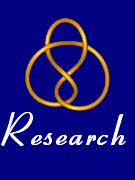





|
The Shape of Knots
Dave Futer

|
|
I am researching the mathematical shape of knots and the spaces around
them. I could give you a tangled extension cord with one end plugged
into the other and say, "Try to untangle this, without separating the
two ends and breaking the circle." If you play with the cord for an hour
or two without success, you might well decide that it's impossible. But
how do you know for sure if some other approach would have worked, or if
there is an actual knot in the cord that prevents it from untangling?
How can you tell if two extension cords form the same knot -- meaning,
can you make them look the same without breaking the circle? Answers to
these mathematical questions turn out to have implications for biology
and physics.
|
|
My research answers questions of this sort by studying geometrical
properties of the space that surrounds a knot. This surrounding space
can be visualized as a solid mold of clay, with a complicated shape that
mirrors the original knot. To gain a better understanding of its shape,
we cut the mold into smaller and simpler pieces. Taking measurements of
the individual pieces and studying how they fit together gives a
manageable way to understand the shape of the whole mold.
|
|

|

Notice how the hyperbolic lines in this picture
form pentagons with all right angles.
|
|
I study the individual pieces of the mold using an unusual form of
geometry, called hyperbolic geometry. This form of geometry measures
distances and angles in a way that is very different from the one we
commonly use, but it shares some important features. In the standard
Euclidean geometry that we study in high school, every pair of points
determines a straight line that represents the shortest way to travel
between the points. This is also true in hyperbolic geometry, even
though straight hyperbolic lines would look curved to our naked eye. We
can use these hyperbolic lines to construct polygons, and measure angles
and areas in the pieces of the mold.
The advantage of hyperbolic geometry is that it provides essential
information about the original knot. We could have tied the same knot in
two different extension cords -- say, a tight knot in a short extension
cord or a loose knot in a longer cord -- and made two very
different-looking molds. Using standard geometric measurements of the
two molds, you might conclude the two knots were completely different,
even though both cords contain the same knot. Hyperbolic geometry, on
the other hand, gives geometric measurements that depend only on the
actual knot we started with, regardless of whether the knot is tight or
loose. Measurements in this geometry give a way to decide if a
particularly messy cord is truly knotted, and if the knots in two cords
are different.
|
|
Although the mathematical approach to knots seems quite abstract, it has
concrete real-world applications. Biologists care about knots because
many DNA molecules -- such as the one on the right -- make a knotted loop.
The knot makes it harder for
a cell to read the DNA code. Physicists often find knots in the magnetic
fields of stars, and knowing the shape of the knot helps them figure out
how a particular star will interact with its surroundings. Ultimately,
however, knots present a beautiful and challenging problem worth
pondering on its own rights.
|
|

|
Acknowledgements: This description of my research was written
during a workshop with Stanford's
I-RITE Program. I am deeply grateful to Carolyn Gale, May Liu, and Tasha
Reddy for helping me revise it.
Picture credits: (1) Painting by Walter Obholzer; (2) Graphic by
Jason
Cantarella; (3) Still image from
Not Knot, University of
Minnesota Geometry Center; (4) Microscope
image from Science 229, 171 (1985).
[Home]
[Research]
[Teaching]
[News]
[Personal]
[Photos]
dfuter at math msu edu
Last modified: Sun Dec 5 15:57:16 PST 2004
|









